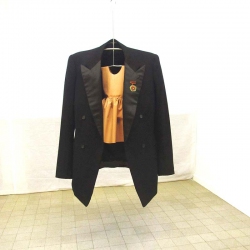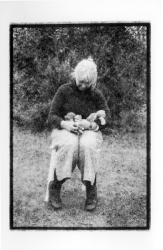Photographs on baryta paper
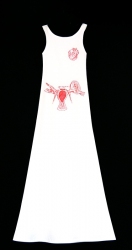
Mixed Media
The transience of the human body through old age or illness is a further starting point. The fascination for anatomy and pathology goes back to childhood memories.
The artist embroiders old anatomical engravings on dresses tailored to her own figure. Such naive anatomical drawings, rendered in this way, convert the bizarre into a more touching and moving image.
She makes casts of faces, hands and feet of family members in clay, wax or plaster which also undergo a transformation. Through this metamorphosis a special relationship arises between the artist and the person whose body she is “borrowing” for her work.
In this way a personal anatomy is born. The anatomy of a family.
The transience of the human body through old age or illness is a further starting point. The fascination for anatomy and pathology goes back to childhood memories.
The artist embroiders old anatomical engravings on dresses tailored to her own figure. Such naive anatomical drawings, rendered in this way, convert the bizarre into a more touching and moving image.
She makes casts of faces, hands and feet of family members in clay, wax or plaster which also undergo a transformation. Through this metamorphosis a special relationship arises between the artist and the person whose body she is “borrowing” for her work.
In this way a personal anatomy is born. The anatomy of a family.
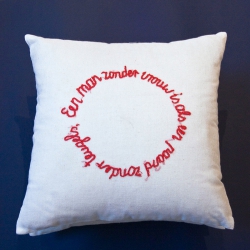
Embroidery on linen, goose feather.
Pillows are soft and serve our rest and peace in contrast to the sayings, which are embroidered on them. These commonplaces rather confuse us instead of giving us the feeling of comfort.
Pillows are soft and serve our rest and peace in contrast to the sayings, which are embroidered on them. These commonplaces rather confuse us instead of giving us the feeling of comfort.
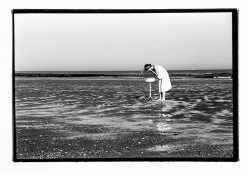
Series of 4 photographs on baryta paper
The series of the 4 photos was taken at the Belgian seaside.
These 4 images show an everyday activity taken out of their usual context and set in an absurd situation.
The series of the 4 photos was taken at the Belgian seaside.
These 4 images show an everyday activity taken out of their usual context and set in an absurd situation.
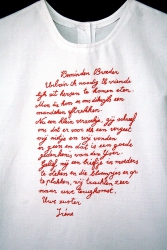
Sculptural installation, found footage, embroidery on linen
The installation is based on letters from the Great War (1917) found in the heritage of a frontline soldier Urbain Bulté. Clarisse (10) and Irene (10) write a letter to their brother Urbain who is fighting as a soldier at the river Yjzer in the western part of Flanders.
The installation is based on letters from the Great War (1917) found in the heritage of a frontline soldier Urbain Bulté. Clarisse (10) and Irene (10) write a letter to their brother Urbain who is fighting as a soldier at the river Yjzer in the western part of Flanders.
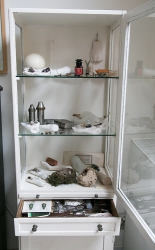
Mixed media
For this work the artist collected insects and medical material.
She was born on the Hungarian Plain in a village, where her father worked as a veterinary doctor. This became the starting point for the work.
.
For this work the artist collected insects and medical material.
She was born on the Hungarian Plain in a village, where her father worked as a veterinary doctor. This became the starting point for the work.
.
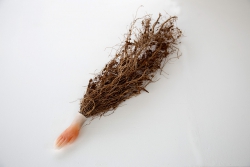
Wax, plaster, unfired clay
Casts of faces, hands and feet of family members may give the illusion that the artist can possess and preserve them in clay, wax or plaster which also undergo a real or imagined transformation. Through this metamorphosis a special relationship arises between the artist and the person whose body she is “borrowing”.
Casts of faces, hands and feet of family members may give the illusion that the artist can possess and preserve them in clay, wax or plaster which also undergo a real or imagined transformation. Through this metamorphosis a special relationship arises between the artist and the person whose body she is “borrowing”.
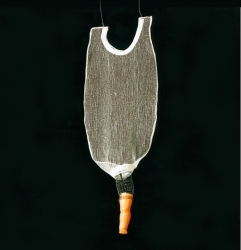
Metal gauze, cotton, plastic
The series of puppet sculptures is based on personal experiences. She is preoccupied with the ambiguity of emotional ties and is questioning the validity of basic human emotions such as the love of a mother or the affection of a child.
The series of puppet sculptures is based on personal experiences. She is preoccupied with the ambiguity of emotional ties and is questioning the validity of basic human emotions such as the love of a mother or the affection of a child.
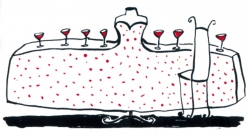
Mixed media
This sculptural work found its inspiration in the 17th and 18th century fashion of women's dresses. The side hoops here turn into a ceremonial table to entertain 12 guests. The table is, however, left untouched and impeccably clean.
An image of a particular event, that may evoke the sublime, which is, however, artificial and overdone at the same time.
This sculptural work found its inspiration in the 17th and 18th century fashion of women's dresses. The side hoops here turn into a ceremonial table to entertain 12 guests. The table is, however, left untouched and impeccably clean.
An image of a particular event, that may evoke the sublime, which is, however, artificial and overdone at the same time.
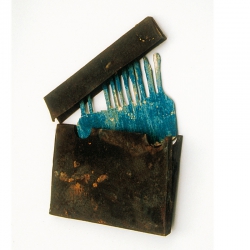
Mixed media
These early works evoke fictional characters. By bringing together everyday objects, the obsession with the sublime is united with the ordinary of day-to-day accumulation. A man and a woman are portrayed as archetypal persons
These early works evoke fictional characters. By bringing together everyday objects, the obsession with the sublime is united with the ordinary of day-to-day accumulation. A man and a woman are portrayed as archetypal persons
